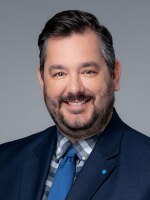The practice of medicine is constantly evolving, and medical schools have to stay on the cutting edge.
That’s not a problem at UC San Diego. The school just opened a four-story state-of-the-art medical training center.
The $70-million facility is well equipped to train doctors:
A patient is wheeled into the emergency room. He’s unconscious.
Four doctors crowd around the gurney. One doctor takes the lead.
"Is he breathing at all spontaneously?" he asks. "OK, Chuck let’s get ready to intubate."
Four doctors-in-training are trying to find out what’s wrong with this man.
"He’s not responding to painful stimuli, so let’s just go with the rock," says the lead doctor. "And we’ve got a pulse of 123, he’s hypoxic to 94 percent…"
One doctor starts an IV drip. Another draws blood.
The patient’s breathing is labored. The monitors show his vital signs are deteriorating.
The lead doctor looks at the monitors and exchanges looks with the others.
"Let’s get the trauma surgeon on the phone, because we need to get this guy to OR, he’s a traumatic OR recess," he says.
This patient is a $150,000 electronically controlled dummy. And these doctors are inside UC San Diego’s new medical training center.
Emergency room physician Bihn Ly says he tries to make the simulations as realistic as possible.
"Rarely do patients come in telling us exactly what’s going on with them," Dr. Ly points out. "They don’t come in with a sign that says, we’re havin’ a heart attack. Part of being an emergency physician is going through the process of being a detective, and figuring out what’s going on."
The training facility is on UC San Diego’s main campus in La Jolla. It’s the new home for more than 600 medical students, residents, and fellows.
The building has classrooms, meeting rooms, and even the largest lecture hall on campus.
But it’s the facility’s Center for the Future of Surgery that’s the real eye-opener.
It’s filled with simulated operating rooms that are better equipped than those found in many hospitals.
Dr. Santiago Horgan is chief of minimally invasive surgery at UC San Diego Medical Center.
"If you come here and you bring any surgeon or an anesthesiologist into this operating room, they will feel like they are in an O.R.," he says emphatically.
Dr. Horgan said these mock operating rooms are where aspiring surgeons, and even those already in practice, can hone their skills.
"And we can teach the residents, faculty from other institutions, surgeons who want to learn new techniques, to practice them here, before they go into the operating room," he continued.
In one of the operating theatres, Dr. Emily Lukacz showed a surgical fellow how to use a robotic surgery machine.
"So use your right hand," she tells the young doctor. "Go ahead and bring it up slowly."
While the aspiring surgeon manipulates the robotic arms with her hands, she looks at a monitor that provides a 3-D image of the surgical site.
Lukacz says this kind of training is absolutely critical.
"There is no question in my mind that this level of training, just as you would for training pilots, requires a significant amount of practice," Lukacz stressed. "And practice in the lab is much safer, and frankly, more reliable, probably, than on real patients."
Dr. Maria Savoia is UC San Diego’s dean of medical education. This building is her baby -- she’s been pushing for it since 1993.
She agrees that all of the newfangled technology is impressive. But she says the ultimate goal of the new center is to help doctors master both the art and the science of medicine.
"And so this building is designed for both of those," Savoia said, "to be able to teach really how to understand what’s going on with patients, and then to do what needs to be done well.”








